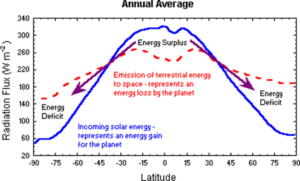General Circulation of the atmosphere
The simplest observed global characteristic of the atmosphere is that the tropics are much warmer than the poles. As discussed earlier, this is a straightforward consequence of the geometry of the earth. The annually averaged incoming solar radiation per unit area of the earth’s surface is much greater at the equator than at the poles . The difference arises because of the fact that the polar regions are covered in ice and snow and therefore reflect much of the incoming radiation back to space. Another fact is that the tropical regions actually receive more energy from the sun than they emit back to space, while the converse is true in high latitudes.

Over the globe, the energy balance is nearly balanced when averaged over a year (incoming equals outgoing). Hence, there must be a process acting to transport excess energy from the tropics to make up the deficit in high latitudes, as depicted schematically in. To compensate for the surplus and deficit of radiation in different regions of the globe, atmospheric and oceanic transport processes distribute the energy equally around the earth. This transport is accomplished by atmospheric winds and ocean currents.

Single-Cell Model of the General Circulation
If the Earth’s surface were smooth, uniform, and stationary, atmospheric circulation would be very simple. The atmosphere would act as a contained fluid and movements within this fluid would be the convective currents caused by temperature and density differences. The latitudinal transfer of heat would result in a single circulation cell, where the surface air converges and rises at the equator, spreads laterally toward the poles, descends and flows back toward equator at the surface. This creates the single cell circulation model possible only on a non-rotating Earth and sun being directly over the equator.

Three-Cell Model of the General Circulation
This model represents the average circulation of the atmosphere and is used to describe the atmospheric transport of energy. It considers effects of coriolis force due to the Earth’s rotation. In this circulation model, the Northern and Southern Hemisphere are each divided into three cells of circulation, each spanning 30 degrees of latitude. The latitudes that mark the boundaries of these cells are the Equator, 30° North and South, and 60° North and South.

Hadley Cell
George Hadley, an English meteorologist, theorized this first circulation cell in 1735. The Hadley cell is the strongest of the three cells of circulation and is formed as warm air rises above the Equator and starts to flow northward. The rising air cools condenses and forms a region of intense clouds and heavy precipitation. This area is called the Inter-Tropical Convergence Zone (ITCZ) and corresponds regions over which the tropical rain forests are found. The ITCZ moves north and south following the sun during the year. Because the stratosphere is stable, rising air that reaches the tropopause, moves poleward. By the time the air moving northward reached about 30° N it has become a westerly wind (it is moving to the east) due to the Coriolis force. Because of conservation of angular momentum, the poleward moving air increases speed. The increased speed and the Coriolis force are responsible for the subtropical jet.
This poleward moving air leads to the formation of semi-permanent high pressure belt at the surface that results from the sinking air at 30°. Once the sinking air reaches the ground, some flows to the equator, turning west (in the northern hemisphere) as it goes due to the Coriolis force. This surface air forms the trade winds which blow steadily from the northeast in the northern hemisphere and southeast in the southern hemisphere.
Polar Cell
This is the northernmost cell of circulation and its mean position is between 60°N and the North Pole. At the pole, cold, dense air descends, causing an area of subsidence and high pressure. As the air sinks, it begins spreading southward. Since the coriolis force is strongest at the poles, the southward moving air deflects sharply to the right. This wind regime is called the surface polar easterlies, although the upper winds are still predominantly from the southwest. Near 60ºN, the southeasterly moving air moving along the surface collides with the weak, northwesterly surface flow that resulted from spreading air at 30°N. This colliding air rises, creating a belt of low pressure near 60°N.
Ferrel Cell
The mid-latitude circulation cell between the Polar cell and the Hadley cell is called the Ferrel cell. The Ferrel cell circulation is not as easily explained as the Hadley and Polar cells. Unlike the other two cells, where the upper and low-level flows are reversed, a generally westerly flow dominates the Ferrel cell at the surface and aloft. It is believed the cell is a forced phenomena, induced by interaction between the other two cells. The stronger downward vertical motion and surface convergence at 30°N coupled with surface convergence and net upward vertical motion at 60°N induces the circulation of the Ferrel cell. This net circulation pattern is greatly upset by the exchange of polar air moving southward and tropical air moving northward

